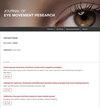为人机界面中的旋转元素选择合适的速度:定量研究
IF 1.3
4区 心理学
Q3 OPHTHALMOLOGY
引用次数: 1
摘要
旋转运动是人机界面中的一种动态符号,在界面和图形设计中受到广泛关注。本研究旨在通过探索视觉系统对简单和复杂旋转图标在每秒 5-1800 度速度范围内的感知偏好,为界面设计建立速度基准。研究对 12 名参与者进行了两次实验,以考察观察者对旋转图标的刚察速度差(JNDS)和感知速度。实验一采用恒定刺激法测量了八个速度等级的速度刚察差,结果范围为 14.9%-29%。在此基础上,实验二提出了在给定范围内的速度序列,并使用评分表方法评估观察者对速度序列快速性的主观感知。研究结果表明,速度的增加会影响区分速度的能力;低速、中速和高速的关键点分别为 10 度/秒、180 度/秒和 720 度/秒。研究发现,形状的复杂程度会调节视觉系统对实际速度的感知,因此当旋转速度超过 180 度/秒时,复杂图标的旋转速度似乎比简单图标快。最重要的是,这项研究将定量方法和计量学应用到了界面设计中,为设计工作流程提供了更科学的方法。本文章由计算机程序翻译,如有差异,请以英文原文为准。
Selecting the appropriate speed for rotational elements in human-machine interfaces: A quantitative study
The motion of rotation, which served as a dynamic symbol within human-computer interfaces, has garnered extensive attention in interface and graphic design. This study aimed to establish speed benchmarks for interface design by exploring visual system preferences for the perception of both simple and complex rotating icons within the velocity range of 5-1800 degrees per second. The research conducted two experiments with 12 participants to examine the observers’ just noticeable difference in speed (JNDS) and perceived speed for rotational icons. Experiment one measured the JNDS over eight-speed levels using a constant stimulus method, achieving a range of 14.9-29%. Building on this, experiment two proposed a sequence of speeds within the given range and used a rating scale method to assess observers ' subjective perception of the speed series' rapidity. The findings indicated that speed increases impacted the ability to differentiate between speeds; key points for categorizing low, medium, and high speeds were identified at 10, 180, and 720 degrees/s, respectively. Shape complexity was found to modulate the visual system's perception of actual speed, such that at rotation speeds above 180 degrees/s, complex icons appeared to rotate faster than simpler ones. Most importantly, the study applied quantitative methods and metrology to interface design, offering a more scientific approach to the design workflow.
求助全文
通过发布文献求助,成功后即可免费获取论文全文。
去求助
来源期刊

Journal of Eye Movement Research
OPHTHALMOLOGY-
CiteScore
2.90
自引率
33.30%
发文量
10
审稿时长
10 weeks
期刊介绍:
The Journal of Eye Movement Research is an open-access, peer-reviewed scientific periodical devoted to all aspects of oculomotor functioning including methodology of eye recording, neurophysiological and cognitive models, attention, reading, as well as applications in neurology, ergonomy, media research and other areas,
 求助内容:
求助内容: 应助结果提醒方式:
应助结果提醒方式:


